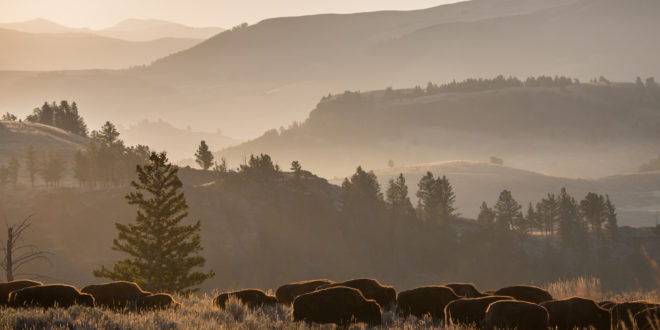Progress has been made on converting part of the Stephens Creek facility into a workable quarantine area to clear bison of brucellosis.
If implemented, the quarantine program would be the latest step away from the current Interagency Bison Management Plan, which holds that state, local and tribal entities must curb bison numbers through slaughter and hunting.
The program would also be the most significant change made since Montana Governor Steve Bullock ordered officials to let bison roam year-round in parts of southern and southwestern Montana.
According to the Bozeman Daily Chronicle, officials in the park have received guidelines from Montana state and federal agencies on how to set up a proper facility. According to park spokesman Jonathan Shafer, officials plan to review the documents and weigh their next steps. We previously reported Yellowstone Superintendent Dan Wenk looked upon quarantine upgrades favorably, saying “We feel like we’re in a better place in terms of doing the research we want to do on these animals.” From the Chronicle:
Quarantine is a process through which bison can be deemed brucellosis free. Brucellosis can cause animals to abort, and the livestock industry fears what the spread of the disease or the mere movement of a potentially infected animal might do to cattle markets. No case of bison transmitting the disease to cattle in the wild has ever been documented.
Certifying the animals as free of brucellosis would allow them to be moved. It’s seen both as a way to reduce the number culled from the Yellowstone population each year and to establish more bison herds around the country.
[…]
The testing protocols say bison could only be released from quarantine after testing negative for brucellosis multiple times. The requirements change based on sex, and based on whether female bison are pregnant.
Males could be released after three negative tests and a year of quarantine. Meanwhile, pregnant females would need to be held for 18 months and test negative five times. Sexually immature females would need to be held the longest, at two-and-a-half years.
A letter from APHIS deputy administrator Jack Shere to Dan Wenk says the Department of Livestock and APHIS would need to inspect the facility before it is used. It also says that APHIS would sign off on the release of any bison from quarantine, and that the three agencies should sign an agreement that lines out their responsibilities.
According to Montana state veterinarian Marty Zaluski, cited by the Chronicle, the quarantine corrals “would need to be lined by two fences set 10 feet apart. Fences around the entire facility and those separating corrals would need to be eight feet tall, have at least 17 horizontal wires and leave no more than three inches between the bottom wire and the ground.”
Background to Quarantine Proposal
Late last month, we reported Yellowstone officials were looking to convert part of the Stephens Creek Bison Capture Facility into a quarantine area following discussions with the Fort Peck Reservation. For the past few years, officials had promised Fort Peck 40 bison to house in their quarantine facility, but all were nearly shipped for slaughter in order to clear room at Stephens Creek. After Governor Bullock intervened, the agencies and entities involved hammered out a compromise: Fort Peck would receive 24 bull bison after they had been quarantined for a while in a set of U.S. Department of Agriculture corrals in Corwin Springs, Montana.
The original 40 had included female bison. The Fort Peck Tribes seeks to establish a breeding herd once quarantine was finished and provide other tribes with bison.
Yellowstone bison are treasured for their “purer” genetic lineage compared to domestic bison, with Yellowstone bison genes much sought after. Indeed, bison once roamed much of the western United States; their current Yellowstone stronghold was created partly by accident, since bison were largely extirpated from their home range in the 18th and 19th centuries.
Hopefully, with the establishment of a successful quarantine program, Yellowstone bison will be able to leave the park with more freedom.
 Yellowstone Insider Your Complete Guide to America's First National Park
Yellowstone Insider Your Complete Guide to America's First National Park





